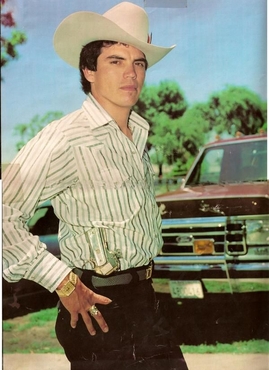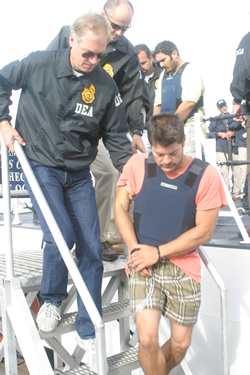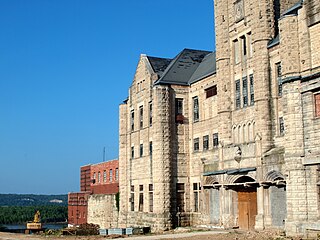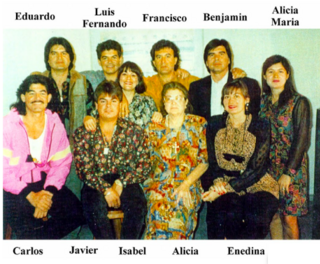Related Research Articles

The Tijuana Cartel or Arellano-Félix-Cartel is a Mexican drug cartel based in Tijuana, Baja California, Mexico. Founded by the Arellano-Félix family, the cartel once was described as "one of the biggest and most violent criminal groups in Mexico". However, since the 2006 Sinaloa Cartel incursion in Baja California and the fall of the Arellano-Félix brothers, the Tijuana Cartel has been reduced to a few cells. In 2016, the organization became known as Cartel Tijuana Nueva Generación and began to align itself under the Jalisco New Generation Cartel, along with Beltrán Leyva Organization (BLO) to create an anti-Sinaloa alliance, in which the Jalisco New Generation Cartel heads. This alliance has since dwindled as the Tijuana, Jalisco New Generation, and Sinaloa cartels all now battle each other for trafficking influence in the city of Tijuana and the region of Baja California.

The New Mexico State Penitentiary riot, which took place on February 2 and 3, 1980, at the Penitentiary of New Mexico (PNM) south of Santa Fe, was the most violent prison riot in U.S. history. Inmates took complete control of the prison and twelve officers were taken hostage. Several inmates were killed by other prisoners, with some being tortured and mutilated because they had previously acted as informants for prison authorities. Police regained control of PNM 36 hours after the riots had begun. By then, thirty-three inmates had died and more than two hundred were treated for injuries. None of the twelve officers taken hostage were killed, but seven suffered serious injuries caused by beatings and rapes.

Rosalino "Chalino" Sánchez Félix was a Mexican singer-songwriter. Posthumously called "El Rey del Corrido", he is considered one of the most influential Mexican narcocorrido singers of the late 20th century. He also composed and sang romantic and radio-friendly songs.

A super-maximum security (supermax) or administrative maximum (ADX) prison is a "control-unit" prison, or a unit within prisons, which represents the most secure level of custody in the prison systems of certain countries.

Oregon State Penitentiary (OSP), also known as Oregon State Prison, is a maximum security prison in the northwest United States in Salem, Oregon. Originally opened in Portland 173 years ago in 1851, it relocated to Salem fifteen years later. The 2,242-capacity prison is the oldest in the state; the all-male facility is operated by the Oregon Department of Corrections (ODOC). OSP contains an intensive management wing, which is being transformed into a psychiatric facility for mentally ill prisoners throughout Oregon.

Menard Correctional Center, known prior to 1970 as Southern Illinois Penitentiary, is an Illinois state prison located in the town of Chester in Randolph County, Illinois. It houses maximum-security and high-medium-security adult males. The average daily population as of 2007 was 3,410.

Francisco Javier Arellano Félix is a former Mexican drug lord who alongside his brothers founded and led the Tijuana Cartel until his capture by the United States Coast Guard on August 16, 2006.

J. Jesús Blancornelas was a Mexican journalist who co-founded the Tijuana-based Zeta magazine, known for its reporting on corruption and drug trafficking. His work encompassed an extensive research on how the drug industry influences local leaders and the police in the Mexican state of Baja California – topics frequently avoided by the rest of the Mexican media.
The Atlanta prison riots were a series of prison riots that occurred at the U.S. Penitentiary in Atlanta, Georgia, United States in November 1987. The riot coincided with a similar riot at the Federal Detention Center in Oakdale, Louisiana.

San Pedro prison or El penal de San Pedro is the largest prison in La Paz, Bolivia and is renowned for being a society within itself. Significantly different from most correctional facilities, inmates at San Pedro have jobs inside the community, buy or rent their accommodation, and often live with their families. Prior to 2009, an illegal tourist trade flourished at the prison, with some tourists staying overnight at a hotel inside; the sale of cocaine base to visiting tourists gave some prisoners a significant income. Elected leaders enforce the laws of the community, primarily through stabbing. The prison is home to nearly 3,000 inmates.

The Missouri State Penitentiary was a prison in Jefferson City, Missouri, that operated from 1836 to 2004. Part of the Missouri Department of Corrections, it served as the state of Missouri's primary maximum security institution. Before it closed, it was the oldest operating penal facility west of the Mississippi River. It was replaced by the Jefferson City Correctional Center, which opened on September 15, 2004.
Antonia Brenner, better known as Mother Antonia, was an American religious sister and activist who chose to reside and care for inmates at the notorious maximum-security La Mesa Prison in Tijuana, Mexico. As a result of her work, she founded a new community called the Eudist Servants of the 11th Hour.
The National Penitentiary Institute of Peru is the government agency charged with incarcerating convicts and suspects charged with crimes. It is part of the Peruvian government's Ministry of Justice.

Carlos Alberto Arellano Félix is a Mexican medical doctor who is known for his illegal involvement in money laundering for the Tijuana Cartel. Carlos was born on the 20th of August in the year 1955 in the city of Culiacán, Sinaloa. Historian Paul Eiss states that Culiacán is the origin of modern drug trafficking and the home of Mexico's most powerful drug cartel. Carlos is currently working as a licensed surgeon. He finished his surgical training at the Universidad Autónoma de Guadalajara The Tijuana Cartel is an organisation that is notorious for being one of the most well-known drug trafficking groups in Mexico to smuggle goods into the United States. Carlos’ family is made up of seven brothers and four sisters who inherited the Arellano Felix Organisation from their godfather, Miguel Ángel Félix. Despite Carlos’ involvement in money laundering for the Tijuana Cartel, he is one of two brothers who remains free and is not wanted by the United States law enforcement.

The Apodaca prison riot occurred on 19 February 2012 at a prison in Apodaca, Nuevo León, Mexico. Mexico City officials stated that at least 44 people were killed, with another twelve injured. The Blog del Narco, a blog that documents events and people of the Mexican Drug War anonymously, reported that the actual (unofficial) death toll may be more than 70 people. The fight was between Los Zetas and the Gulf Cartel, two drug cartels that operate in northeastern Mexico. The governor of Nuevo León, Rodrigo Medina, mentioned on 20 February 2012 that 30 inmates escaped from the prison during the riot. Four days later, however, the new figures of the fugitives went down to 29. On 16 March 2012, the Attorney General's Office of Nuevo León confirmed that 37 prisoners had actually escaped on the day of the massacre. One of the fugitives, Óscar Manuel Bernal alias La Araña, is considered by the Mexican authorities to be "extremely dangerous," and is believed to be the leader of Los Zetas in the municipality of Monterrey. Some other fugitives were also leaders in the organization.
The Altamira prison brawl was a deadly fight that occurred on 4 January 2012 in Altamira, Tamaulipas, Mexico. Officials from the state of Tamaulipas confirmed that 31 people were killed, with another thirteen injured. The fight started after a drug gang burst into a section of the prison where they were banned from, attacking their rival gang housed there, triggering the fight. During the altercation, the inmates used several kinds of cold weapons (non-firearms) to kill their opponents. The prisoners also used sticks and knives to massacre the members of the rival gang.
The following is a timeline of the history of the city of Tijuana, Baja California, Mexico.

On 10 February 2016, a prison riot broke out at the Topo Chico prison near Monterrey, in northern Mexico. 49 inmates were killed during the riot and ensuing fire. The riot was the most deadly in Mexican penal history, surpassing the death toll of the 2012 Apodaca prison riot. After the rioting, authorities uncovered 'luxury cells' prison leaders had. Among the items confiscated included televisions, mini-fridges, aquariums, and saunas.
Edgar Veytia Cambero is a Mexican jurist. He held the position as Attorney General of Nayarit, from 2013 to 2017.

The COVID-19 pandemic has impacted prisons globally. There have been outbreaks of COVID-19 reported in prisons and jails around the world, with the housing density and population turnover of many prisons contributing to an increased risk of contracting the virus compared to the general population. Prison crowding and lack of sanitation measures contribute to the risk of contracting diseases in prisons and jails. As a mitigation measure, several jurisdictions have released prisoners to reduce density and attempt to reduce the spread of the illness. There have also been protests among prisoners, riots and prison breaks in multiple countries in response to prisoner anger over their risk of contracting illness in prison conditions. Before the COVID-19 pandemic, health services within prisons had issues providing adequate care for incarcerated people, and this has only been exacerbated by the impacts of COVID-19. Minority groups within the prison system have been disproportionately affected by the COVID-19 pandemic.
References
- ↑ Jordan, Mary (March 25, 2002). "In Mexico, Justice at a Price". The Washington Post .
- ↑ Kahn, Carrie (February 6, 2014). "Tijuana Prisoner: I Was Forced To Dig Drug Tunnel To San Diego". WBUR-FM .
- ↑ "Mexico's La Mesa Penitentiary: An Experiment in Humanity". Office of Justice Programs . 1995.
- ↑ ROTELLA, SEBASTIAN (March 27, 1994). "Doing Time in Tijuana : In La Mesa Penitentiary, Prisoners Live With Their Families, Rich Inmates Control the Real Estate and Everything--Even Guns and Drugs--Has a Price" . Los Angeles Times .
- ↑ "I'll take you inside La Mesa prison in Tijuana". San Diego Reader . June 25, 1992.
- ↑ Marosi, Richard (October 17, 2013). "Sister Antonia Brenner dies at 86; nun moved into Tijuana prison to tend to inmates". Los Angeles Times .
- ↑ Hammond, Jody (October 11, 2023). "Opinion: This nun lived in a Tijuana prison by choice" . The San Diego Union-Tribune .
- ↑ "Bulldozers bring prison reform". The Week . January 8, 2015.
- ↑ O’CONNOR, ANNE-MARIE (September 16, 2002). "Infamous Prison City Torn Down" . Los Angeles Times .
- ↑ "Swift shake-up at notorious Tijuana prison". The Seattle Times . Associated Press. August 21, 2002.
- ↑ "PRISON CONDITIONS IN MEXICO" (PDF). Human Rights Watch . March 8, 1991.
- ↑ "Mexican jail riot leaves 19 dead". BBC News . 18 September 2008.
- ↑ "Police kill 19 inmates in Mexico prison riot". NBC News . September 18, 2008.
- ↑ Torres, Blanca (February 10, 2022). "'Idolo': Why Singer Chalino Sánchez Is Still a Legend 30 Years After His Unsolved Murder". KQED-FM .
- ↑ DIBBLE, SANDRA (May 9, 2014). "Marine vet moved from Tijuana's La Mesa prison" . The San Diego Union-Tribune .
- ↑ Valencia, Nick; Morris, Jason; Yan, Holly (May 30, 2014). "U.S. Marine tells of abuse in Mexican prison, but says he's still hopeful". CNN .